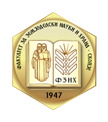CHANGES OF NUTRITIONAL PROPERTIES OF THREE VARIANTS PEPPERS BY PROCESSING OF PICKLED RED PEPPERS
Abstract
Blanching was done at 85-90 °C for 5 min. To the pasteurized pepper, acetic acid was added at a concentration of 1.5 % in terms of finished product, which belongs to the low marinated products. Pasteurization is carried out at T 92 °Cfor 30 minutes. The chemical properties were determined by analyzing the following parameters: total dry matter, carbohydrates, proteins, oils, total acids, vitamin C, β-carotene and ash, both in fresh and in pasteurized peppers. Based on the obtained results the quality and nutritional composition were determined. The variety horgosh shows the highest content of total dry matter (11.45 %), vitamin C (138.9 mg/100 g), βcarotene (22.7 mg/100 g), and the highest energy value (41.7 kcal). In the gourp of the pasteurized peppers, the variety of palanechko chudo has been characterized by the lowest average value of total dry matter (7.49 %) and lowest total energy value (24.6 kcal); the variety of kurtovska kapija had the lowest contents of vitamin C (52.1 mg/100 g) and β-carotene (6.09 mg/100 g).
References
Castro S. M., Saraiva J. A., Lopes-da-Silva J. A., Delgadilla I., Loey A. V., Smout C., Hendrickx M., (2008), Effect of thermal blanching and of high pressure treatments on sweet green and red bell pepper fruits (Capsicum annuum L.), Article 21, Food Chemistry 107, 1436–1449;
Cruz, R. M. S., Vieira, M. C., Silva, C. L. M. (2011), Impact of Thermal Blanching and Thermosonication Treatments on Watercress (Nasturtium officinale) Quality: Thermosonication Process Optimisation and Microstructure Evaluation, Food and Bioprocess Technology, 4, 11971204;
Food and Agriculture Organization (2003), Food Energy: Methods of Analysis and Conversion Factors. Report of a technical workshop. Food and Nutrition Paper 77;
Guil -Guerrero J. L., Martínez-Guirado C. Ma del Mar Rebolloso-Fuentes M. Del M., CarriqueP´erez A, (2006), Nutrient composition and antioxidant activity of 10 pepper (Capsicum annuun) varieties, Eur Food Res Technol, 224, 1-9;
Gvozdenovid Đ., Takač A. (2004) Paprika, Poljoprivredna biblioteka;
Hornero-Méndez, D.; Gómez-Ladrón De Guevara, R.; Mínguez-Mosquera, M. I. (2000), Carotenoid biosynthesis changes in five red pepper (Capsicum annuum L.) cultivars during ripening. Cultivar selection for breeding. J. Agric. Food Chem.,48, 3857-3864;
Jašid M., (2007), Tehnologija voda i povrda I, Tehnološki fakultet Univerziteta, Tuzla;
Koprivnjak O. (2014), Kvalitet, sigurnost i konzerviranje hrane, udžbenik iz kolegija „Uvod u prehrambene tehnologije”, Medri, Rijeka;
Niketid-Aleksid G., (1994), Tehnologija voda i povrda, Poljoprivredni fakultet, Beograd;
Official Methods of Analysis (AOAC), (1995), 16th Eds. USA p.780;
Pérez-Gálvez, A., Garrido-Fernбndez J., Mínguez-Mosquera M. I., (1999) Participation of pepper seed oil in the stability of paprika carotenes. JAOCS 76, 1449-1454;
Pérez-López A. J., López-Nicolas J. M., Núñez-Delicado E., Del Amor F. M., and CarbonellBarrachina A., (2007), Effects of Agricultural Practices on Color, Carotenoids Composition, and Minerals Contents of Sweet Peppers, cv. Almuden, J. Agric. Food Chem. 55, 8158–8164
Sethu Priya K. M., Prabha T. N. and Tharanathan R.N., (1996), Post-harvest biochemical changes associated with the softening phenomenon in Capsicum annum fruits, Phytochemistry, 42, 961-966;
Silva C. L. M., Oliveira, F. A. R. and Hendicks M., (1993), Modeling optimum processing conditions for the sterilization of pre-packed foods., Food Control, 4, 67-78;
Tijskens, L. M. M. (2000). Acceptability. In L. R. Shewfelt, & B. Bruckner (Eds.), Fruit and vegetable quality: an integrated view. New York: CRC Press;
Vereš M. (2004), Principi konzervisanja namirnica, Univerzitet u Beogradu, Poljoprivredni fakultet, Beograd;
Zeb A., Murkovic M., (2010), Thin-Layer Chromatographic Analysis of Carotenoids in Plant and Animal Samples, Journal of Planar Chromatography 23;
http://www.canterbury.ac.nz/media/documents/science-outreach/vitamin _iodine. pdf" 15.09.2017)



